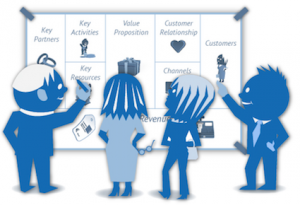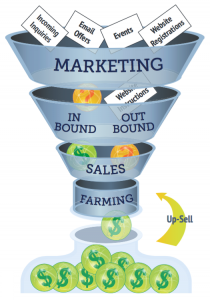How Do You Cross the Chasm and the Tipping Point? Part 2
 Most information technology companies face two challenges as they make it out of the startup stage and look to accelerate growth. The first one is crossing the chasm; I wrote about this in the first part of this series of posts. The second one is how to pass the tipping point.
Most information technology companies face two challenges as they make it out of the startup stage and look to accelerate growth. The first one is crossing the chasm; I wrote about this in the first part of this series of posts. The second one is how to pass the tipping point.
Think about an airplane taking off or the launch of a space rocket. The first part of the journey requires immense amounts of energy, but as soon as a certain momentum is achieved or you are free of the earth’s gravity then it requires substantially less energy to maintain that speed or even to accelerate. You have the exact same phenomenon in business. Getting started and getting the first few customers are really hard. Then you get better at it and customers become more comfortable buying from you now that they are not alone and suddenly demand explodes – you have passed the tipping point.
The hard life in the West
 Life on the western side of the tipping point is really tough and exhausting. Making your potential customers aware that you even exist is an uphill battle. Increasing traffic to your web site and views on your Youtube channel takes major investments in promotion and social media activity. Making potential customers sign up for your newsletters and download the white papers you offer goes slowly. Your win rate on the deals that your sales force is working on is still low and the recommendations and testimonials you get are few and far between. Finding additional staff to support your growth is still a slow and expensive process, where you need to find and convince people to join your cause.
Life on the western side of the tipping point is really tough and exhausting. Making your potential customers aware that you even exist is an uphill battle. Increasing traffic to your web site and views on your Youtube channel takes major investments in promotion and social media activity. Making potential customers sign up for your newsletters and download the white papers you offer goes slowly. Your win rate on the deals that your sales force is working on is still low and the recommendations and testimonials you get are few and far between. Finding additional staff to support your growth is still a slow and expensive process, where you need to find and convince people to join your cause.
However, you continue to fight and optimize all the steps in your revenue generation process and then suddenly everything seems to take on a life of it’s own. The work you have invested in your on & off-line activities suddenly improves without any obvious explanation. You start to receive an increasing number of inbound leads and are flooded with unsolicited job applications from people that would love to work for you.
What happened?
Congratulations, you just passed the tipping point and are on trajectory to market leadership.
Paradise is in the East
 On the eastern side of the tipping point you enjoy the exponential impact of the increasing buzz around your products. As more people read, watch and download your material they start sharing it with their network, that will share it with their networks, that will… As more customers talk and write positively about you, other potential customers will recognise your existence, will feel more comfortable dealing with you and will have an easier time making a decision in your favour.
On the eastern side of the tipping point you enjoy the exponential impact of the increasing buzz around your products. As more people read, watch and download your material they start sharing it with their network, that will share it with their networks, that will… As more customers talk and write positively about you, other potential customers will recognise your existence, will feel more comfortable dealing with you and will have an easier time making a decision in your favour.
On the eastern side of the tipping point the sales and marketing expenses per revenue dollar will decrease, leaving you more profit to invest in all corners of your business, improving your overall competitiveness and helping you accelerate even further.
How do you get there?
The tipping point is around the 20 % market share depending on the fragmentation and maturity of your market. For many executives that seems a completely unrealistic objective or at least one that is very, vey far away, but there are a few tricks that can help you get there much faster than you would think.
Segment your market
 The first trick is to narrow your market focus. Simply take away those segments of your market where you are less successful and/or where you position is weakest. The potential customers in your core market must perceive themselves as belonging to this market. When that is the case then all your marketing and communication material can focus on the specific issues that these customers face and each new customer is reinforcing your position.
The first trick is to narrow your market focus. Simply take away those segments of your market where you are less successful and/or where you position is weakest. The potential customers in your core market must perceive themselves as belonging to this market. When that is the case then all your marketing and communication material can focus on the specific issues that these customers face and each new customer is reinforcing your position.
It is obviously easier to get to 20% market share in a small market than in a big market, but you will also get there faster because of your laser sharp focus.
Track your market share
 You cannot manage the growth of your market share if you don’t monitor and keep track of your position in the market. Measuring market share in the information technology industry where companies work hard in differentiating themselves from their competitors is by no means trivial. Find a simple proxy that you can update regularly and use that as the yardstick.
You cannot manage the growth of your market share if you don’t monitor and keep track of your position in the market. Measuring market share in the information technology industry where companies work hard in differentiating themselves from their competitors is by no means trivial. Find a simple proxy that you can update regularly and use that as the yardstick.
As you grow and improve your position then the industry analysts will take over this job for you and you will have to use their yardstick because that is what your customers do.
Facilitate the buyers journey
In this year of the Olympic games it is worth while noticing that all the athletes have trained hard to qualify for the games and when they finally get there they are strangely enough not supposed to focus on winning medals. They actually work very hard not thinking about the medals at all. They have to focus on the next match or heat only and do well enough to qualify for the following race. When they reach the final then they have to focus on winning this and when they do then they are awarded the gold medal. Focusing on winning the race and not on getting the gold medal may sound like semantic finesse, but I can guarantee you that we have serious psychology at play here.
 The analogy to business is fairly obvious (apart from the fact that there are no silver or bronze medals in business). Buyers are on a journey that some day (tomorrow, next week, in a month, next quarter, next year or at some future date) will result in a purchase of something that you can provide. Meticulously facilitating this process and patiently building the awareness, followers, engagement and pipeline to make more and more of these decision go your way is the recipe for making it past the tipping point. Paying attention only to those who are ready to buy next week and ignoring all the others will not take you past the tipping point.
The analogy to business is fairly obvious (apart from the fact that there are no silver or bronze medals in business). Buyers are on a journey that some day (tomorrow, next week, in a month, next quarter, next year or at some future date) will result in a purchase of something that you can provide. Meticulously facilitating this process and patiently building the awareness, followers, engagement and pipeline to make more and more of these decision go your way is the recipe for making it past the tipping point. Paying attention only to those who are ready to buy next week and ignoring all the others will not take you past the tipping point.
Introduce division of labour
Accelerating your market share requires introducing division of labour in your revenue generation process. Organise business development, marketing, sales development, sales and account management under one executive to reflect that revenue generation is a process with many steps and emphasise that the ultimate objective for the executive is increased market share.
 Define a set of KPIs that the manager in each of the revenue generation functions has to deliver on supporting the next step in the chain.
Define a set of KPIs that the manager in each of the revenue generation functions has to deliver on supporting the next step in the chain.
Break down each managers’ overall objectives and define a set of KPIs that can indicate if the performance of her processes are steadily improving.
There is conceptually no difference between optimising a production or logistics process and optimising a revenue generation process. First you define the base line, then you set your objectives and then you lay out the strategy and plan for what to do. You break down the process in all its individual steps and identify the bottlenecks and inefficiencies. Then you fix them one by one. You keep monitoring the outcome and make corrections if a fix didn’t work or created a new problem.
The revenue generation process depends heavily on the behaviour of human beings outside your control, but the outcome of human behaviour is actually measurable and even statistically predictable. If you are not familiar with statistical analysis then you need to add such skills to your revenue generation staff. Without analytical skills you are fumbling in the dark.
Enjoy the journey and celebrate the progress.








